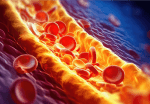For many years, percutaneous transluminal coronary angioplasty (PCTA) has expanded significantly worldwide. However, despite the demonstrated advantages of intravascular ultrasound (IVUS) in terms of minimal luminal area, reduced cardiovascular events, and restenosis, its use is not very common due to various reasons. On the other hand, optical coherence tomography (OCT) offers even higher resolution than...
What to Do in Cases of AMI with Multivessel Disease
The presence of lesions in multiple vessels is common in ST-segment elevation myocardial infarction (STEMI). It has been shown that, when they are treated in a second procedure, patients have a better outcome. To date, there is limited information available on percutaneous transluminal coronary angioplasty (PTCA) in vessels with severe non-culprit lesions during primary angioplasty....
ROTA.shock Outcomes: Intravascular Lithotripsy vs. Rotational Atherectomy
At present, severe calcified coronary stenosis poses a significant challenge for PCI. A successful intervention will require plaque modification prior stenting, seeing as sub-expansion has been associated with worse clinical outcomes at followup. The tools normally used to treat these complex lesions include specialized balloons such as cutting, scoring, and high pressure balloons, as well...
ESC 2023 | OCTIVUS TRIAL: Is OCT Superior?
Researchers conducted a multicenter randomized study involving 2008 patients undergoing coronary angioplasty (PCI). In this group, 1005 patients underwent a procedure guided by OCT, and 1003 patients by IVUS. The average age of participants was 65 years, 21% of subjects were women, and there were no significant differences between both groups. The primary endpoint was...
AMI following Coronary Artery Dissection: Higher Mortality?
Though rare, spontaneous coronary artery dissection (SCAD) might lead to MI, most commonly affecting young middle aged women. In these cases, the angiographic image will present a characteristic double lumen, and an intramural hematoma in the coronary artery wall. Normally, it will be treated medically. However, a small number of cases presenting STEMI will require...
ESC 2023 | STOPDAPT-3
Short Dual antiplatelet therapy (DAPT), one to three months, followed by P2Y12 inhibitor monotherapy has been shown to reduce bleeding events without increased cardiovascular events vs. standard DAPT, according to guidelines. However, the rate of major bleeding within the first month after procedure remains significant when using these strategies. The use of aspirin-free therapies (ASA)...
ESC 2023 | FIRE-Trial: Physiology Guided Complete Revascularization Benefits Elderly Patients with Myocardial Infarction
Patients over 75 with acute coronary syndrome (ACS) are often badly represented in most significant studies. In this context, the FIRE study looked to determine whether physiology guided complete revascularization is superior to culprit-only revascularization in elderly patients with multivessel disease suffering acute MI. The study included SCA patients over 75, hospitalized for both STEMI...
ESC 2023 | OCTOBER TRIAL: Should We Begin to Consider OCT for Bifurcation Lesions?
The OCTOBER Study randomized 1201 patients with bifurcation lesions in a 1:1 ratio to undergo percutaneous transluminal coronary angioplasty (PTCA) guided by optical coherence tomography (OCT) or by angiography. The primary endpoint (PEP) was major adverse cardiovascular events (MACE) over a 2-year period. Group characteristics were similar. The average patient age was 66 years, most...
MACT Study: Monotherapy with P2Y12 Inhibitor Associated with Colchicine after Acute Coronary Syndrome
Dual antiplatelet therapy (DAPT) is the current standard for preventing thrombotic events in high-risk patients with coronary artery disease, as well as in patients with acute coronary syndrome (ACS) undergoing percutaneous coronary intervention (PCI). However, this approach increases the risk of bleeding. To reduce this risk, there have been studies that discontinued the use of...
EASTBOURNE Registry: Use of Sirolimus-Coated Balloons in Coronary Artery Disease
The introduction of drug coated balloons (DCB) has become an innovative therapeutic alternative to current treatments. Paclitaxel-coated balloons (PCB) have been used to treat in-stent restenosis (ISR) and also approach CAD in native arteries. More recently, sirolimus-coated balloons (SCB) are being looked at as part of pilot studies and smaller registries with preliminary results. The...






